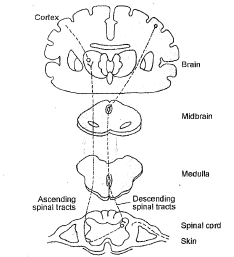Pain and theory of pain transmission -Pain impulses are transmitted to the spinal cord by two types of fibers, thin Myelinated have faster conduction A-delta fibers and slower conducting unmyelinated C-fibers. Pain that may be described as ‘sharp’ or ‘pricking’ is easily localized by A-delta fibers. The afferent nerve fibers enter the spinal cord through the dorsal root and synapse in the dorsal horn. The dorsal horn consists of several layers (laminae) with inter connection Laminae II comprise an area called substantia gelatinosa (SG). Substance P is released at synapses in the SG and is thought to be a major neurotransmitter of the pain impulses. Ascending spinal pathways for nociceptive impulses located in the ventral half of the spinal cord are the spinothalamic tract (STT) and the spinoreticular tract (SRT). STT conveys information about the nature and location of the stimulus to the thalamus and then to the cortex for interpretation. SRT activates autonomic response.

Pain Modulations
Endorphins are thought to suppress pain by acting presynaptically to inhibit release of the neurotransmitter substance Prostraglandins acting postsynaptically to inhibit conduction of pain impulses. Descending spinal pathways from the thalamus through the midbrain and medulla to the dorsal horns of the spinal cord conduct nociceptive inhibitory impulses. Serotonin is one neurotransmitter hat supports these inhibitory impulses.
Pain and Theories of Pain Transmission
Various theories of pain transmission have been proposed:
I ) Affect Theory
Pain is an emotion and its intensity depends on the meaning of’ the past involved, does not include physiologic aspect.
2 ) Specificity Theory
Specific pain receptors project impulses over neural pain pathways to the brain, does not account for physiologic aspect of pain perception and variability of response.
SEE ALSO : RESPONSE TO INJURY NURSING
3)Pattern Theory
Pain result from combined effect of’ stimulus intensity and summation of impulses in the dorsal horn of the spinal cord, does not account for psychologic aspects.
4) Gate control Theory
It does not fully explain. Pain transmission but serves as a basis for understanding pain transmission.
Gate control theory theory proposed that the substantia gelatinosa (SG) in the spinal cord act as a gating mechanism to permit or inhibit passage of pain impulses. The gate can be closed by nerve impulses from the large non-nociceptive A-delta and A-alpha fibers from the descending pathways. Impulses conducted over large fibers not only closed the gate but also sent immediately to the cortex for rapid identification, evaluation and modification of the sensory inputs.
Pain Experience
The pain experience of every individual includes the perception of pain and response to pain.
Pain Perception
Perception of pain takes place in cortex (cognitive, evaluative function) as a result of the stimuli transmitted up the spinothalamic and thalamic cortical tracts.
.Pain Detection Threshold
The intensity at which then noxious stimulus is subjectively judged as painful is called pain detection threshold.
Pain Tolerance
Pain Tolerance Pain Tolerance will terribly between totally different people during a same state of affairs and in same individual in numerous state of affairs
Pain and theory of pain transmission – Meaning of Pain
Pain has different meaning for each person which may differ for the same person at different times. For some they view as negative experience and for some as positive aspect, e.g., harm or danger, punishment {‘or skin, challenge, recurrence of illness, aging, release from unwanted responsibilities.
Response to Pain
People response to pain in different ways depending on the perception of the pain. Some may be Fearful, apprehensive, and anxious others are tolerant and optimistic. Some may weep, scream, beg for relief’ or help, threaten to destroy themselves; some may lie quietly in the bed.
Factors influence response to pain are:
- Meaning of pain to individual
- Degree of pain perception
- Past experience
- Cultural values
- Social expectations
- Physical and Mental health
- Parental attitudes towards pain
- Fear and anxiety
- Age
- Preparation for pain context
- Health professional responses
- Sex
